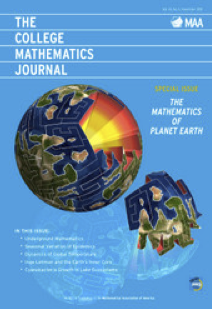The November issue of The College Mathematics Journal is a special theme issue supporting the Mathematics of Planet Earth initiative, MPE 2013. The articles in this extra large issue discuss a wide range of earth science and environmental questions. The issue is freely available to all.
Charles Hadlock applies undergraduate mathematics (linear equations, interpolation, geometry) to modeling the movement of water underground. Meredith Greer, Holly Ewing, Kathleen Weathers, and Kathryn Cottingham describe a mathematical/ecological collaborative study of a cyanobacterium (attractively named Gloeo) in New England lakes. Osvaldo Marrero describes a statistical method for detecting seasonal variation in an epidemic. (Such variation may betray an environmental influence.) And Christiane Rousseau describes the discovery of the Earth’s inner core by Inge Lehmann.
Four articles/Classroom Capsules/Student Research Projects concern climate change. Two papers (by, respectively, James Walsh and Richard McGehee, and Emek Köse and Jennifer Kunze) apply dynamical systems and differential equations to modeling global temperature; a Classroom Capsule by John Zobitz discusses carbon absorption in forests; and a Student Research Project by Lily Khadjavi describes how to coax students to model the rate of climate change.
The issue begins with a guest editorial by Mary Lou Zeeman relating mathematics to sustainability and concludes with a review by Ben Fusaro of the recent book “Mathematics for the Environment” by Martin Walter.
— Michael Henle, Editor
